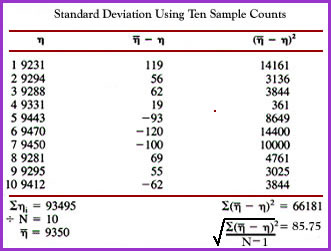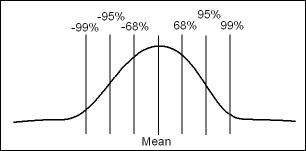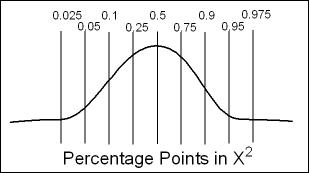| Peak | Where does statistics relate to these concepts? |
| High Voltage | |
| Statistical flux | |
| Pixel size | |
| Gray scale | |
| Acquisition time and the amount of counts | |
| Activity injected to patient |
- Error is a measurement where there is a difference between the true value and variation being measured
- Blunders (error) are so obvious in nature that they are easy to detect (can be prevented)
- Incorrect set (wrong peak) with imaging equipment
- Injecting the wrong radiopharmaceutical
- Determinate error are known systematic error, this can be caused by (usually something that is unavoidable):
- Experimental design
- Malfunctioning equipment
- Lack of correction from external influences (lack of counts in an image)
- Indeterminate error is yet another form, it is also known as random error
- Things that cannot be reduced by correcting for those external factors
- Radiation decay is a random event, hence it is considered a form of (indeterminate) statistical error
- Types of error can also be defined from the diagrams below
- Inaccurate, unbiased, and imprecise
- Inaccurate, biased, and precise
- Inaccurate, biased, and imprecise
- Accurate, unbiased, and precise
- What is the difference between precession and accuracy? Answer

- When considering radioactive decay it should be noted that the number of dpm is only an average, it is not a constant
- Disintegration of a radioactive atom is a random event and hence decay is considered a random variable
- If you count a source for one minute and recount it the following minute its cpm will most likely be different
- Half-life is only an average and not necessary considered a "true" value
- This website states that 99mTc has a T1/2 of 6.03 hours yet this other link shows it at 6.02 hours
- When considering precision and accuracy of a radioactive sample one must consider the randomness of decay (note: the greater the counts collected the less error is given to the analysis of the equation). Examples of where error can be an issue with a nuclear exam:
- Number of counts being accumulated or time necessary to acquire a certain amount of counts
- Dose to be administered to the patient (the greater the dose the more the counts)
- Scan speed when looking at whole body imaging (the slower the scan the more counts collected)
- Amount of counts/slice in a SPECT scan
- Consider counting a 137Cs source 25 times and then graphing it below. A distribution of counts will generate a bell curve - Poisson distribution
- Now let us considered standard deviation (SD)
- As compared to the distribution above let us take a look at a normal SD using Poisson distribution. Note how the graph above and below are similar in design
- From the graph above N = the number of counts collected which is 10,000 counts that shows its distribution along a bell curve.
- One SD of 10,000 counts is 1,000 demonstrated by the smaller bell. To determine SD you must find the square root of the total counts
- Now let us take a look at effects on the amount of counts as it relates to the SD
- From the above table one can consider several points
- Increasing the number of counts decreases the percent error and reduces statistical error
- Increasing the number of SD increases the range, increases the percent error, and improves statistical accuracy
- Hence it is important to realize the importance of increasing counts in a sample in order to reduce the percentage of error (and %SD)
- Another interesting point is to look at how the change in counts (increased counts effects SD and Poisson distribution
- Less counts shows a curve with a larger width
- Increased counts shows a curve with a decreased width


![]()

- As a rule of thumb - 10,000 counts is considered adequate
- Consider √10,000 = 100 where 1 SD = 100
- Consider the sample error, 100/√10,000 = 1% for one SD
- By increasing your % error you increase your level of confidence - 2 SD = +/- 200 (2%) and 3 SD = +/- 300 (3%)
- Further analysis of percent error can be noted from the table above
- 1 SD = 68%, which means that in any given population 68% of the sample will fall in that range
- 2 SD = 95%,
- 3 SD = 99%
- Hence the greater the number of SDs the greater the probability that your sampling will fall within that appropriate range
- Mean - is the value (counts) obtained by adding together all the counts from every sample collected and dividing by the total number of data sets collected
- Median - when values (counts) are placed in order of magnitude (smallest to largest), the median is the center value, which lays half way. Also referred to as the 50th percentile
- Mode - is the value (counts) that appears most often in the data set
- When a radioactive source is counted numerous times (at the same time interval) a number of counting samples are generated. If one were to graphically display this the distribution would appear as a bell shaped curve
- As stated before this is how Poisson distribution fits in. This is similar to Gaussian distribution which also generate this bell shaped curve
- Poisson distribution is used to determine the mathematical probability that an event will occur. By analyzing a series of events a mean number can be generated. By applying a SD one can then determine the statistical probability of the next event. Hence SD is used to note the amount of times an event will occur within a specific range or frequency. Example - 2 SD takes into account that any future events will have a 95% probability that it will occur within the same range. As you increase the amount of %SD you increase the probability catching the next occurrence. To assess multiple events the following formula is applied:
- Application - If you were to count 137Cs 10 times in a well counter you would get 10 samples and the formula above is used to calculate the standard deviation from the mean
- The table below demonstrates the actual events and calculations used to determine SD
- If graphed, the events would be distributed accordingly along a bell shaped curve



- The actual definition is found here. In the nuclear medicine arena it is testing to see if a counter (ex. well counter) is recording counts that are "true." You could say that you are testing a detector's reliability to correctly detect counts from a source of radiation. What we do know is that decay is random, which means that the counting instrument is counting in a random fashion. Therefore there must be enough variation in counts to pass the test. The formula for X2
- Now let us apply the formula where n = the number of times a 137Cs sample was counted in a well counter. The average of those events is determined, then subtracted by each event. The events are then squared and the total value is summed. This value is then divided by the mean. Those calculations are noted below
- Next you must apply the degrees of freedom which is determined by the following formula (N - 1) = degrees of freedom (df)
- N = the amount of sample counts taken, usually this value is 10
- Subtracting by 1 the degrees of freedom becomes 9
- You then want your X2 value falls between 0.1 and 0.9. Does it?
- If it were below 0.1 what would that mean?
- If it were above 0.9 what would that mean
- What do we use those values?
- The value fell below 0.1 then the likelihood of that event falls way below left tail of distribution
- If the value fell above 0.9 then the likelihood of that event falls way above the right tail of distribution
- Less than 0.1 means there is not enough variation
- Greater than 0.9 means there is too much variation
- Note the distribution of this frequency in the graph below


| df | 0.995 | 0.99 | 0.975 | 0.95 | 0.90 | 0.10 | 0.05 | 0.025 | 0.01 | 0.005 |
| 1 | --- | --- | 0.001 | 0.004 | 0.016 | 2.706 | 3.841 | 5.024 | 6.635 | 7.879 |
| 2 | 0.010 | 0.020 | 0.051 | 0.103 | 0.211 | 4.605 | 5.991 | 7.378 | 9.210 | 10.597 |
| 3 | 0.072 | 0.115 | 0.216 | 0.352 | 0.584 | 6.251 | 7.815 | 9.348 | 11.345 | 12.838 |
| 4 | 0.207 | 0.297 | 0.484 | 0.711 | 1.064 | 7.779 | 9.488 | 11.143 | 13.277 | 14.860 |
| 5 | 0.412 | 0.554 | 0.831 | 1.145 | 1.610 | 9.236 | 11.070 | 12.833 | 15.086 | 16.750 |
| 6 | 0.676 | 0.872 | 1.237 | 1.635 | 2.204 | 10.645 | 12.592 | 14.449 | 16.812 | 18.548 |
| 7 | 0.989 | 1.239 | 1.690 | 2.167 | 2.833 | 12.017 | 14.067 | 16.013 | 18.475 | 20.278 |
| 8 | 1.344 | 1.646 | 2.180 | 2.733 | 3.490 | 13.362 | 15.507 | 17.535 | 20.090 | 21.955 |
| 9 | 1.735 | 2.088 | 2.700 | 3.325 | 4.168 | 14.684 | 16.919 | 19.023 | 21.666 | 23.589 |
| 10 | 2.156 | 2.558 | 3.247 | 3.940 | 4.865 | 15.987 | 18.307 | 20.483 | 23.209 | 25.188 |
| 11 | 2.603 | 3.053 | 3.816 | 4.575 | 5.578 | 17.275 | 19.675 | 21.920 | 24.725 | 26.757 |
| 12 | 3.074 | 3.571 | 4.404 | 5.226 | 6.304 | 18.549 | 21.026 | 23.337 | 26.217 | 28.300 |
| 13 | 3.565 | 4.107 | 5.009 | 5.892 | 7.042 | 19.812 | 22.362 | 24.736 | 27.688 | 29.819 |
| 14 | 4.075 | 4.660 | 5.629 | 6.571 | 7.790 | 21.064 | 23.685 | 26.119 | 29.141 | 31.319 |
| 15 | 4.601 | 5.229 | 6.262 | 7.261 | 8.547 | 22.307 | 24.996 | 27.488 | 30.578 | 32.801 |
| 16 | 5.142 | 5.812 | 6.908 | 7.962 | 9.312 | 23.542 | 26.296 | 28.845 | 32.000 | 34.267 |
| 17 | 5.697 | 6.408 | 7.564 | 8.672 | 10.085 | 24.769 | 27.587 | 30.191 | 33.409 | 35.718 |
| 18 | 6.265 | 7.015 | 8.231 | 9.390 | 10.865 | 25.989 | 28.869 | 31.526 | 34.805 | 37.156 |
| 19 | 6.844 | 7.633 | 8.907 | 10.117 | 11.651 | 27.204 | 30.144 | 32.852 | 36.191 | 38.582 |
| 20 | 7.434 | 8.260 | 9.591 | 10.851 | 12.443 | 28.412 | 31.410 | 34.170 | 37.566 | 39.997 |
| 21 | 8.034 | 8.897 | 10.283 | 11.591 | 13.240 | 29.615 | 32.671 | 35.479 | 38.932 | 41.401 |
| 22 | 8.643 | 9.542 | 10.982 | 12.338 | 14.041 | 30.813 | 33.924 | 36.781 | 40.289 | 42.796 |
| 23 | 9.260 | 10.196 | 11.689 | 13.091 | 14.848 | 32.007 | 35.172 | 38.076 | 41.638 | 44.181 |
| 24 | 9.886 | 10.856 | 12.401 | 13.848 | 15.659 | 33.196 | 36.415 | 39.364 | 42.980 | 45.559 |
| 25 | 10.520 | 11.524 | 13.120 | 14.611 | 16.473 | 34.382 | 37.652 | 40.646 | 44.314 | 46.928 |
| 26 | 11.160 | 12.198 | 13.844 | 15.379 | 17.292 | 35.563 | 38.885 | 41.923 | 45.642 | 48.290 |
| 27 | 11.808 | 12.879 | 14.573 | 16.151 | 18.114 | 36.741 | 40.113 | 43.195 | 46.963 | 49.645 |
| 28 | 12.461 | 13.565 | 15.308 | 16.928 | 18.939 | 37.916 | 41.337 | 44.461 | 48.278 | 50.993 |
| 29 | 13.121 | 14.256 | 16.047 | 17.708 | 19.768 | 39.087 | 42.557 | 45.722 | 49.588 | 52.336 |
| 30 | 13.787 | 14.953 | 16.791 | 18.493 | 20.599 | 40.256 | 43.773 | 46.979 | 50.892 | 53.672 |
| 40 | 20.707 | 22.164 | 24.433 | 26.509 | 29.051 | 51.805 | 55.758 | 59.342 | 63.691 | 66.766 |
| 50 | 27.991 | 29.707 | 32.357 | 34.764 | 37.689 | 63.167 | 67.505 | 71.420 | 76.154 | 79.490 |
| 60 | 35.534 | 37.485 | 40.482 | 43.188 | 46.459 | 74.397 | 79.082 | 83.298 | 88.379 | 91.952 |
| 70 | 43.275 | 45.442 | 48.758 | 51.739 | 55.329 | 85.527 | 90.531 | 95.023 | 100.425 | 104.215 |
| 80 | 51.172 | 53.540 | 57.153 | 60.391 | 64.278 | 96.578 | 101.879 | 106.629 | 112.329 | 116.321 |
| 90 | 59.196 | 61.754 | 65.647 | 69.126 | 73.291 | 107.565 | 113.145 | 118.136 | 124.116 | 128.299 |
| 100 | 67.328 | 70.065 | 74.222 | 77.929 | 82.358 | 118.498 | 124.342 | 129.561 | 135.807 | 140.169 |
